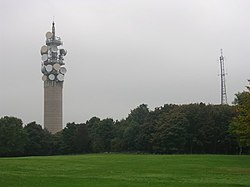BT Group plc is a British multinational telecommunications holding company headquartered in London, England. It has operations in around 180 countries and is the largest provider of fixed-line, broadband and mobile services in the UK, and also provides subscription television and IT services.
Telecommunications in the United Kingdom have evolved from the early days of the telegraph to modern broadband and mobile phone networks with Internet services.

The BT Tower is a grade II listed communications tower in Fitzrovia, London, England, owned by BT Group. It was also known as the GPO Tower and the Post Office Tower. It was later officially renamed the Telecom Tower. The main structure is 581 feet (177 m) high, with a further section of aerial rigging bringing the total height to 620 feet (189 m).

Tropospheric scatter, also known as troposcatter, is a method of communicating with microwave radio signals over considerable distances – often up to 500 kilometres (310 mi) and further depending on frequency of operation, equipment type, terrain, and climate factors. This method of propagation uses the tropospheric scatter phenomenon, where radio waves at UHF and SHF frequencies are randomly scattered as they pass through the upper layers of the troposphere. Radio signals are transmitted in a narrow beam aimed just above the horizon in the direction of the receiver station. As the signals pass through the troposphere, some of the energy is scattered back toward the Earth, allowing the receiver station to pick up the signal.
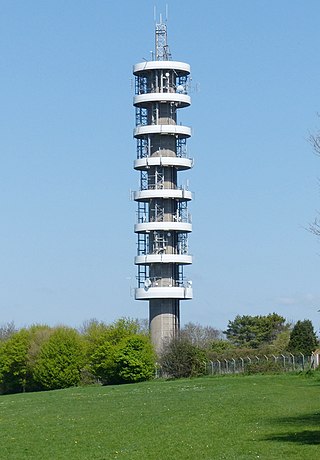
Telecommunications towers in the United Kingdom are operated mainly by Arqiva. Arqiva operates the transmitters for UK terrestrial TV and most radio broadcasting, both analogue and digital. BT also operates a number of telecommunications towers in the UK.

The Peterborough transmitting station is a broadcasting and telecommunications facility at Morborne Hill, near Peterborough, England.

The BT Tower, formerly known as the Post Office Tower and the GPO Tower, is a landmark and telecommunications tower in Birmingham, England. It is the tallest structure in the city. Its post office code was YBMR.

Radio masts and towers are typically tall structures designed to support antennas for telecommunications and broadcasting, including television. There are two main types: guyed and self-supporting structures. They are among the tallest human-made structures. Masts are often named after the broadcasting organizations that originally built them or currently use them.

Pye Green BT Tower is a 96.9-metre (318 ft) tall telecommunication tower built of reinforced concrete at Pye Green, Staffordshire, England. Standing on the far southern edge of Cannock Chase, it is one of fourteen telecommunication towers in the United Kingdom built of reinforced concrete. Pye Green was constructed as part of the British Cold War "Backbone" radio communications network.
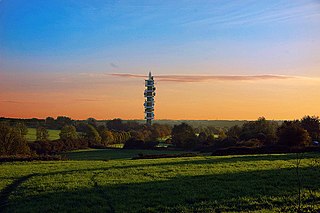
Purdown BT Tower, also known as Purdown Transmitter, is a 70.1 metres (230 ft) tall telecommunications tower in Bristol, England. Built in 1970 for the British Telecom microwave network, it is now used to transmit radio and provide mobile phone coverage.
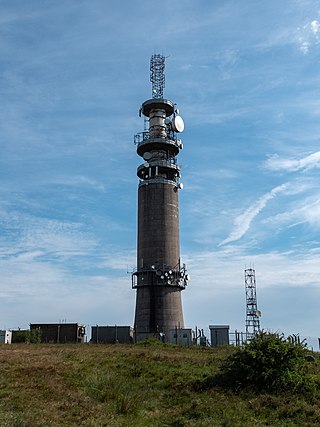
Sutton Common BT Tower is a 72-metre (238-foot) radio tower built of reinforced concrete at Macclesfield, Cheshire, England. Sutton Common was originally conceived as part of the 1950s 'Backbone' chain designed to provide the UK and NATO with survivable communications during nuclear war.

The Tinshill BT Tower is a 60.96 metres ( 200 ft) tall telecommunication tower located on the east side of Otley Old Road in the north of Leeds, West Yorkshire, England. It is in an elevated part of Leeds, with its base 192 metres above sea level. It is one of fourteen BT towers built of reinforced concrete.
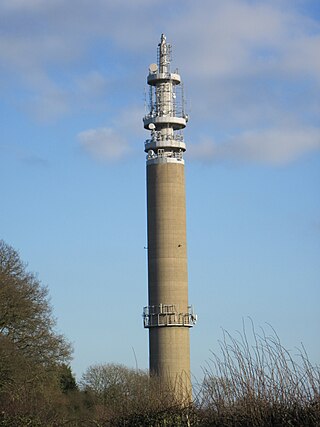
Stokenchurch BT Tower is a telecommunications tower built of reinforced concrete at Stokenchurch, Buckinghamshire, England. Reaching to 340.5 metres (1,117 ft) above mean sea level, it dates from 1963 and is 99.4 metres (326 ft) tall. There are four platforms at the top that are used to attach microwave transmission drums and other antennas.
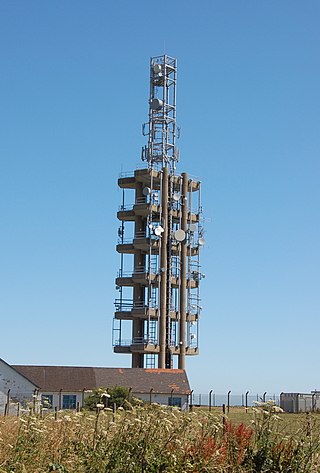
Tolsford Hill BT Tower is a telecommunication tower built of reinforced concrete at Tolsford Hill on the North Downs near Folkestone, Kent. Tolsford Hill BT Tower is one of the few British towers built of reinforced concrete and is 67.36 metres high.

Wotton-under-Edge Tower is a 76.2 metres tall telecommunication tower built of reinforced concrete at Wotton-under-Edge in Gloucestershire, UK. Wotton-under-Edge Tower is one of the few British towers built of reinforced concrete.

Microwave transmission is the transmission of information by electromagnetic waves with wavelengths in the microwave frequency range of 300 MHz to 300 GHz of the electromagnetic spectrum. Microwave signals are normally limited to the line of sight, so long-distance transmission using these signals requires a series of repeaters forming a microwave relay network. It is possible to use microwave signals in over-the-horizon communications using tropospheric scatter, but such systems are expensive and generally used only in specialist roles.
The British Telecom microwave network was a network of point-to-point microwave radio links in the United Kingdom, operated at first by the General Post Office, and subsequently by its successor BT plc. From the late 1950s to the 1980s it provided a large part of BT's trunk communications capacity, and carried telephone, television and radar signals and digital data, both civil and military. Its use of line-of-sight microwave transmission was particularly important during the Cold War for its resilience against nuclear attack. It was rendered obsolete, at least for normal civilian purposes, by the installation of a national optical fibre communication network with considerably higher reliability and vastly greater capacity.
Trans Canada Microwave or Trans-Canada Skyway was a microwave relay system built in the 1950s to carry telephone and television signals from Canada's east coast to its west coast. Built across the nation, the towers ranged in height from nine metres high, to one in northern Ontario that was over 100 metres high. The system included 139 towers spanning over 6,275 kilometres and cost $50 million.

AT&T Communications, Inc., doing business as AT&T Communications, was a division of the AT&T Corporation that, through 23 subsidiaries, provided interexchange carrier and long-distance telephone services.
Filtronic is a UK public limited company (PLC) that is AIM-listed on the London Stock Exchange (FTC.L). It is a designer and manufacturer of RF, microwave, and millimeter-wave (mmWave) components and subsystems for applications in telecommunications, defence, space and transport. It is headquartered at NETPark in County Durham with other facilities in Leeds and Manchester and a US manufacturing site in Salisbury, MD.
